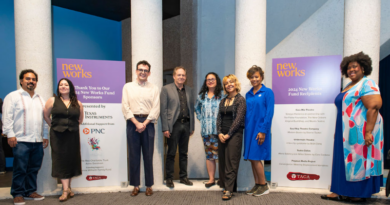PCCI: High Thanksgiving Mobility Adds To COVID-19 Threat
As local officials begin to see the impact of the Thanksgiving holiday on COVID-19 cases and hospitalizations and a U.S. Food and Drug Administration advisory committee is set to discuss emergency use authorization of Pfizer’s COVID-19 vaccine candidate, here’s what you need to know today:
- PCCI: High Thanksgiving mobility adds to COVID-19 threat;
- Dallas County reports 1,348 COVID-19 cases, 33 more deaths;
- Dallas Public Library expands hotspot lending program.
PCCI: High Thanksgiving mobility adds to COVID-19 threat
The Parkland Center of Clinical Innovations’ (PCCI) Vulnerability Index team announced this week that the vulnerability index observed significant increases in vulnerability to COVID-19 infection in Dallas County as of November as new cases rise.
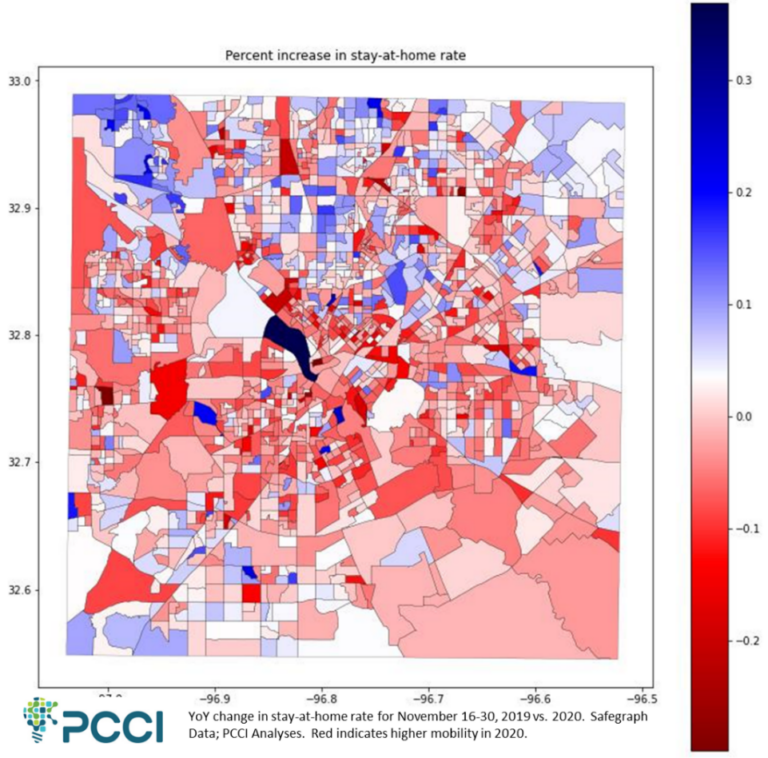
The team also noted the 0.47% year-over-year in mobility during the Thanksgiving holiday, which is a similar rate compared to pre-pandemic Thanksgiving in 2019.
“PCCI analysis indicates a systemic increase in people leaving their home in the two-week period around Thanksgiving. Paired with the dramatic increase in the Vulnerability Index, our community will be challenged through the December holidays and into the first part (of) 2021,” said Thomas Roderick, senior director of data and applied sciences at PCCI.
PCCI’s Vulnerability Index determines communities at risk by examining comorbidity rates, including chronic illnesses such as hypertension, cancer, diabetes, and heart disease; areas with high density of populations over the age of 65; and increased social deprivation such as lack of access to food, medicine, employment, and transportation. These factors are combined with dynamic mobility rates and confirmed COVID-19 cases where a vulnerability index value is scaled relative to July 2020’s COVID-19 peak value.
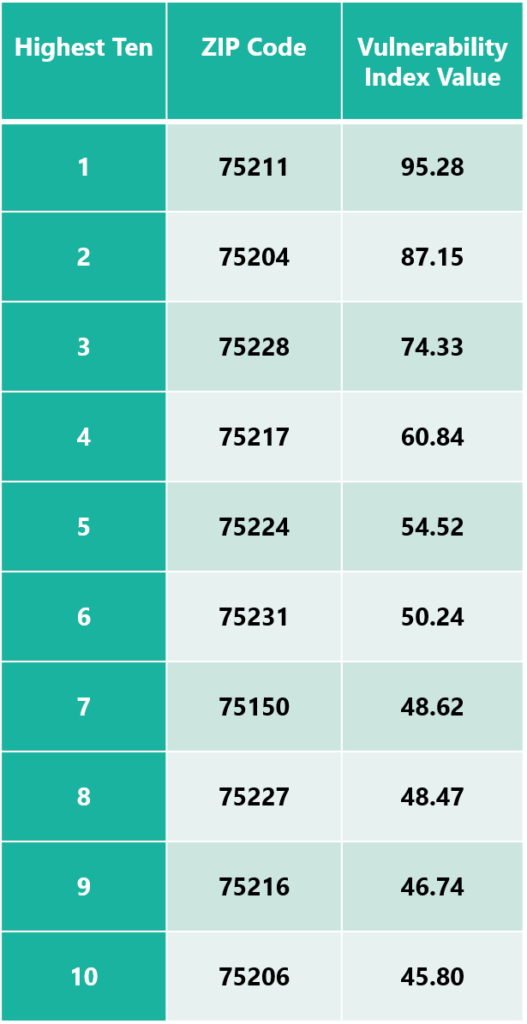
The Vulnerability Index reports that in November the ZIP code with the highest vulnerability value continued to be 75211, around Cockrell Hill. This area has been a high-risk area since the launch of PCCI’s Vulnerability Index.
The ZIP code 75204, which is northeast of downtown Dallas and intersected by U.S. Highway 75, now has the second-highest VI value in Dallas County. The area has seen a rapid increase in its vulnerability since July when its VI value was outside the top ten most at-risk ZIP codes.
In general, the top five most vulnerable ZIP codes showed the most extreme increases and exceeded the highest values in as of November, but all ten ZIP codes had increased year-over-year mobility and reflect the COVID-19 case counts that have increased generally across the county.
“Overall, what we are seeing is the increase in confirmed COVID-19 cases and mobility drive an increase in vulnerability in Dallas County,” said Roderick. “Mobility and socioeconomic deprivation are highly correlated and a potential target for community and public health interventions. Socioeconomic factors affecting mobility include crowded living conditions, type and industry of work, especially client-facing jobs or crowded work environments.”
Dallas County reports 1,348 COVID-19 cases, 33 more deaths
Dallas County Wednesday reported 1,348 COVID-19 cases–1,090 confirmed and 258 probable – and 33 deaths.
The county’s reported a cumulative total of 138,233 cases and 1,275 confirmed deaths, as well as a cumulative total of 14,055 probable cases and 42 probable deaths.
“This is the second highest number of deaths we’ve reported in one day from COVID-19 and a chilling reminder of the importance of making good choices at this time of extremely high community spread,” said Dallas County Judge Clay Jenkins. “The deaths we report today are a direct correlation to the high number of cases reported several weeks ago. The decisions that we make today will determine how many cases are confirmed in 7 to 14 days, how many hospitalizations we have three weeks from now, and how many deaths we report at this time next month.”
The additional deaths include a Dallas man in his 20s, a Dallas man in his 30s, a Balch Springs woman in her 40s, a Dallas man in his 40s, two Dallas men in their 50s, a Duncanville woman in her 50s who died in a hospital emergency room, a Dallas woman in her 50s, a Mesquite woman in her 50s, a Lancaster man in his 50s, a Dallas woman in her 60s, a Dallas man in his 60s, a Mesquite woman in her 60s, a Mesquite man in his 60s, a Lancaster man in his 70s, four Dallas men in their 70s, a Dallas woman in her 70s, a Dallas woman in her 80s who didn’t have underlying conditions, a Dallas man in his 80s, a Dallas man in his 90s, a Hutchins woman in her 90s, and a Cedar Hill man in his 90s. Unless otherwise noted, they had underlying conditions.
The deaths reported Wednesday also include two men in their 70s who died at Dallas long-term care facilities, a man in his 80s who lived at a Dallas facility, a woman in her 80s who lived at a Lancaster facility, a man in his 80s who died at a Dallas facility, a man in his 80s who lived at a Dallas facility, and two men in their 90s who died at Dallas facilities.
Of the total confirmed deaths reported to date, about 23% have been associated with long-term care facilities.
The county also reported Wednesday there are 101 active long-term care facility outbreaks–the highest number of facilities with outbreaks since the start of the pandemic.
A total of 857 COVID-19 cases have been reported from these facilities over the past 30 days, the county says, including 328 staff members. During this timeframe, 38 have been hospitalized, and 30 have died, including two deaths of staff members.
The county also reported 24 outbreaks in congregate-living facilities like homeless shelters, group homes, and halfway homes, during the past 30 days, associated with 155 cases, including five hospitalizations and two deaths. One facility has reported 87 confirmed COVID-19 cases.
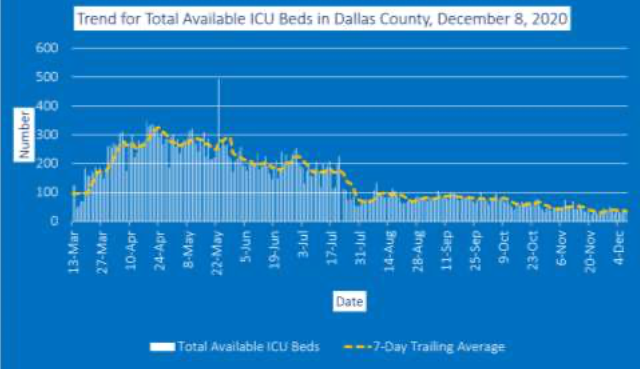
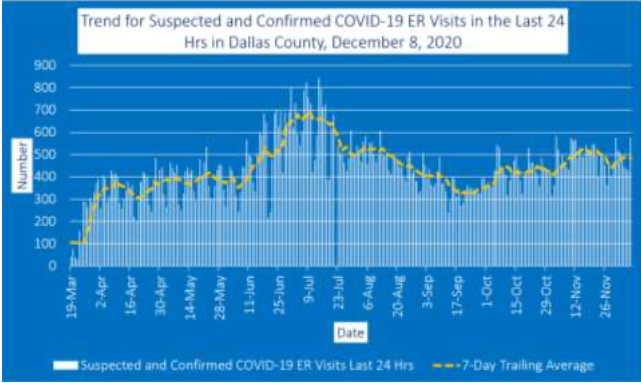
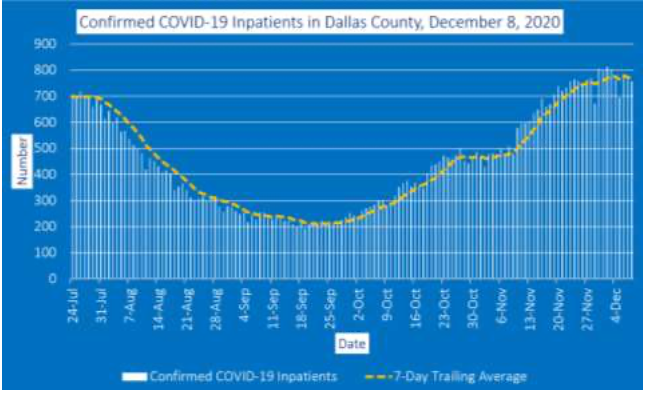
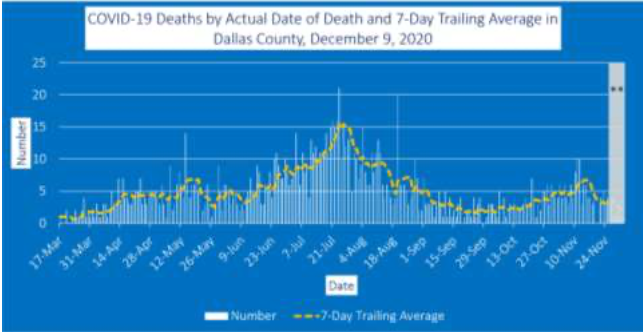
There were 758 COVID-19 patients in hospitals in Dallas County Tuesday, and 576 emergency room visits for COVID-19 like symptoms during the same time period, which represents around 21 percent of all emergency department visits in the county according to information reported to the North Central Texas Trauma Regional Advisory Council.
The percentage of respiratory specimens testing positive for the virus that causes COVID-19 has also increased, the county says, with 22.3% of symptomatic patients presenting to area hospitals testing positive in the week ending Nov. 28.
There have been 4,520 COVID-19 cases in school-aged children and staff reported from 735 separate K-12 schools in Dallas County during the past 30 days including 681 staff members. Of these cases, 534 have been associated with extracurricular activities, including athletics.
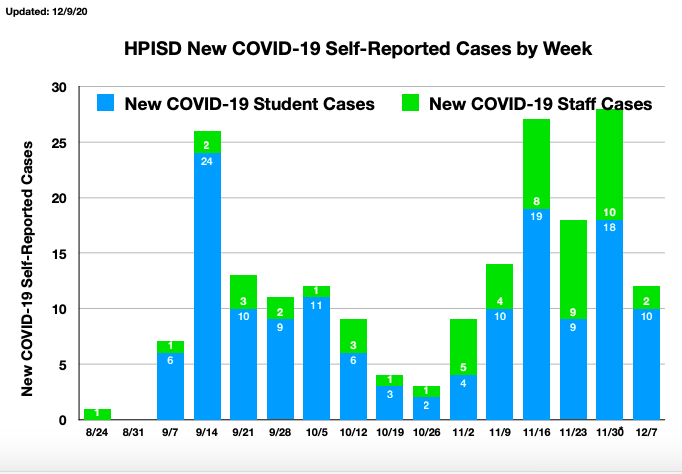
As of Wednesday, Highland Park ISD reported three cases among students at Armstrong, two among students at Boone, one case in a staff member assigned to Hyer, one case in a staff member assigned to University Park, two among students there, three among staff members assigned to McCulloch Intermediate, one case in a student there, one case in a student at Highland Park Middle School, one case among a staff member assigned to Highland Park High School, six among students there, and one case in an administration member, according to the district’s COVID-19 webpage.
As of Wednesday, Dallas ISD reported 1,783 total cases districtwide, 772 among campus staff, 192 among central staff, and 819 among students, according to the district’s COVID-19 dashboard.
Dallas Public Library expands hotspot lending program
Dallas residents without home broadband will now have 2,000 more ways to access internet, thanks to Dallas Public Library’s expanded hotspot lending program.

Starting Dec. 15, every Dallas Public Library location (except for Bookmarks at NorthPark Center) will have at least 85 hotspots available for at-home internet use. Cardholders are encouraged to put their names on the waitlist now to check out a hotspot as they become available. Dallas City Council approved the purchase of 2,100 additional hotspots during the budget process in September.
“These past eight months we’ve heard first-hand from our customers just how important having internet was to their quarantine life,” said Library Director Jo Giudice. “Now more than ever, online access is essential for people to be able to work, go to school, apply for aid, make doctor appointments – even church is online.”
Hotspots can be requested online at www.dallaslibrary.org, by phone at 214-670-7809, or by contacting a local library branch. The hotspots can be checked out for 30 days with the option to renew if there are no outstanding requests. Up to five devices can be used on one hotspot. Dallas Public Library remains closed to prevent the spread of COVID-19, instead offering curbside pick-up of materials and virtual programming.
“The additional hotspots are an important part of providing the library’s core service of computer access,” Giudice said. “To that end, library locations serving populations with a greater digital divide will have more hotspots available at the launch to ensure the people who need it most have equitable access.”
Hotspots can be placed on request just like a library book and picked up through the Library-To-Go curbside service at all Dallas Public Library locations (except Bookmarks at NorthPark Center). Hotspots can be returned in the book drop at any library location.
Free and secure outdoor public WiFi hotspots are available to use between 7 a.m. and 9 p.m. every day in the parking lots of four locations: Prairie Creek, Paul Laurence Dunbar Lancaster-Kiest, Highland Hills, and Dallas West.
A library card is free for any Dallas resident. For information on the free programs and services available at Dallas Public Library, visit www.dallaslibrary.org.









